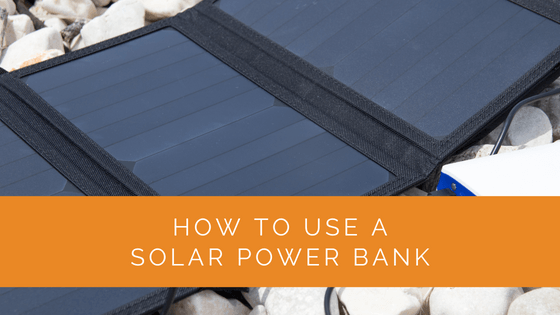Switching to Solar Power Banks is eco-friendly, but do you know what they are and how to use them?
A solar power bank is a valuable technology for charging your mobile smartphones and tablets that may be charged using sunshine or a wall outlet. They usually have USB ports or discharging connectors. Solar power banks give power bank technology a boost in dependability and functionality.
Solar power banks incorporate a single photovoltaic cell into the case, while others have foldable solar cells. The size of the battery capacity varies as well. Most power banks are DC power supplies that always use high-efficiency lithium-ion batteries.
What is the best way to use a solar panel power bank with the sun’s energy if you are wondering? Treat this article as your personalised user manual to know more about this unique type of power bank.
Contents
- 1 Key Takeaways
- 2 Using a Solar Power Bank to Charge a Mobile Phone
- 3 How Often Can You Charge your Phone through the Solar Power banks?
- 4 Precautions to Take When Charging Cell Phones
- 5 Solar Panels Bank Charging
- 6 How to Use a Battery Bank
- 7 Case Study: Efficient Use of Solar Power Banks in Remote Locations
- 8 Expert Insights From Our Solar Panel Installers About Using Solar Power Banks
- 9 Our Expertise in Solar Products
- 10 Conclusion
Key Takeaways
- A solar power bank is a technology that can charge mobile devices using solar energy or a wall outlet, providing eco-friendly charging options.
- To use a solar power bank, plug your mobile device into its USB outlet, and it will begin charging. Some power banks have LED lights to indicate charging status.
- The number of times you can charge your phone with a solar power bank depends on the bank’s capacity and your phone’s battery capacity. Still, it’s typically around 500 charging-discharging cycles. Proper care, like avoiding complete discharges and water exposure, is essential for longevity.
Using a Solar Power Bank to Charge a Mobile Phone
Power banks have a USB outlet and high battery capacity to plug a USB cable into your mobile phones. When electronic devices are connected, certain portable power banks begin their charging capabilities instantaneously, while others require the user to press a button to charge devices.
Most portable solar chargers will include little LED lights that indicate whether they will charge or discharge. The LED lamps will glow as charging ports begin charging the multiple devices and progressively flicker off as the power bank’s battery depletes and the cell phone battery has enough power.
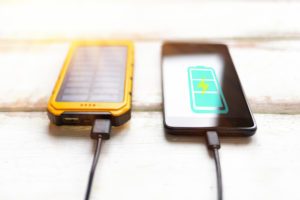
How Often Can You Charge your Phone through the Solar Power banks?
The number of times you could use solar charging with the solar power bank is determined by the capability of the solar charger and the phone’s batteries.
Split the solar power bank’s battery capacity by the phone’s battery capacity as a general guideline. This will estimate how often you can recharge your phone with the solar charger.
If your fully charged power bank supply has 20,000 hours of battery life and your smartphone has a built-in battery, it would mean five complete charges = 20,000 x 4,000.
Even though the equation is correct in theory, a few things prevent us from harnessing power for the potential power stored.
To begin with, entirely depleting solar power bank cells is not recommended. Using all 20,000 mAh of the power bank’s capacity may harm it entirely, making it more difficult to charge a solar power bank again, even if you provide as much direct sunlight.
Furthermore, there are power losses when recharging your phone or keeping your battery bank working. As a result, the solar power bank depends on the product’s work and model to utilise it anywhere from 60% to 80% of the capability of the foldable solar panels.
Most solar power banks typically have a lifetime of around 500 charging-discharging sessions. As a result, if a smartphone can be recharged four times with just a fully loaded power bank, you may charge your phone around 500 x four times = 2000 per cent throughout the power bank’s life.
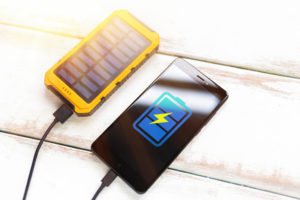
Precautions to Take When Charging Cell Phones
Solar power cells are complicated devices that incorporate various types of technology in a tiny space despite their size. They should not be completely discharged or charged immediately, especially when using a solar panel.
Most manufacturers warn consumers against charging their phones when using built-in solar panel batteries in direct sunlight. This may be acceptable for solar adapters that do not have a rechargeable battery; however, it is not recommended that solar energy banks recharge the solar cells while a smartphone is being charged.
The portable solar power bank must not be exposed to water damage or submerged in water due to all the electronics involved.
When the smartphone is recharged and electricity flows through a circuit, that’s even more crucial. Water-resistant power banks would be an exception, but they should remain far from water.
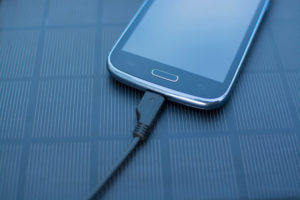
Solar Panels Bank Charging
Its defining feature is a solar power bank’s capacity to be charged by solar electricity. This allows for a greater reliance on off-grid situations for longer periods.
Some power banks include a big solar collector and 28W solar panels in their electric field, making them largely self-contained and eliminating the need for line charging.
On the other side, some, including one with 5W solar panels, have enough photovoltaic power to enhance the battery but cannot rely on solar.
The following are the operating instructions to charge a solar power bank:
Solar Powered Charging
Unfold the power bank (for foldable devices) and put it on the floor or a pedestal to replenish a solar energy bank with direct sunlight. Some solar chargers come with a hook to attach to a bag or tent.
The panel(s) should be free of any shading caused by neighbouring impediments. Even partial shade can limit the power output of a solar panel by a significant amount. This also implies that any debris or dirt on the cell’s surface area should be removed.
Remember not to attach your phones when the power bank recharges. Also, Auxiliary photovoltaic power panels can be connected to some current power cells for charging. This could result in substantially faster charging.
The LED lights would progressively light up when the battery pack within is replenished with solar power. A separate ‘solar LED light’ may be used to confirm that the solar charge has begun and that the exposure’s location and duration are sufficient.
The time it would take to recharge the battery of a solar charger fully can range from under 60 minutes to a few hours, determined by the size of something like the solar panels, the concentration of sunshine, and the size of your power bank’s batteries.
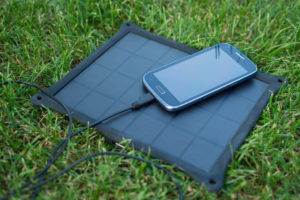
Charging from the Wall
A solar power bank can be charged with a wall charger relatively straightforwardly. All you need now is a USB wall charger, which you probably already have. The LED lights indicate the charge level stated previously.
Besides the two techniques mentioned above, solar energy banks aren’t designed to be charged. For instance, using a USB port on a laptop to recharge them might not be the best option.
How to Use a Battery Bank
Power banks should, in theory, be ready to use right out of the box. Producers, on the other hand, do not include a complete charge. As a result, after the battery pack is unpacked, it is recommended that you charge it.
Case Study: Efficient Use of Solar Power Banks in Remote Locations
Background
A team of outdoor enthusiasts frequently ventured into remote areas for hiking and camping, where access to electrical outlets was unavailable. They relied heavily on electronic devices for navigation, communication, and documentation. The group decided to invest in solar power banks to keep their devices charged during these expeditions, ensuring they remained connected and safe.
Project Overview
The primary goal was to select and use solar power banks that could reliably charge their devices, such as smartphones, GPS units, and cameras, even in areas with limited sunlight. The project involved evaluating the performance of different solar power banks, optimising their usage, and ensuring proper maintenance practices were followed.
Implementation
- Selection of Solar Power Banks: The team chose high-capacity solar power banks with a combination of foldable solar panels and built-in lithium-ion batteries. The selected models offered a balance between portability and energy storage, capable of charging multiple devices simultaneously.
- Optimal Usage Techniques:
- Charging Strategy: The team was instructed to charge the power banks fully before departure using a wall outlet. During the expedition, they used solar energy to top up the power banks, ensuring they always had a backup power source.
- Positioning and Sunlight Exposure: The group learned to position the solar panels in direct sunlight, avoiding shaded areas and adjusting the angle to maximise exposure. They used portable stands and hung the panels on backpacks during hikes to keep them oriented towards the sun.
- Device Charging Protocol: Devices were charged one at a time to prevent overloading the power bank. The team prioritised essential devices, ensuring that navigation and communication tools were always powered.
- Maintenance and Care:
- Regular Cleaning: The solar panels were kept clean from dust and debris to maintain efficiency. The team used soft cloths to wipe the panels daily.
- Avoiding Complete Discharge: To prolong battery life, the team was advised to keep the power banks charged above 50% whenever possible. They avoided using the power banks until fully discharged.
- Water Protection: Given the outdoor conditions, the power banks were stored in waterproof cases, protecting them from potential water exposure.
Results
The use of solar power banks proved highly effective, providing reliable power throughout the expeditions. The team was able to maintain communication, navigate safely, and document their experiences without interruption. The solar power banks performed well, even in less-than-ideal sunlight conditions, thanks to the team’s adherence to best practices for positioning and maintenance.
Summary
Solar power banks are invaluable for outdoor enthusiasts who need reliable power sources in remote locations. This case study demonstrates the importance of selecting the right equipment, understanding optimal usage techniques, and following maintenance guidelines. By doing so, users can ensure their solar power banks provide consistent and efficient power, enhancing the safety and enjoyment of their outdoor adventures.
At Solar Panels Network, we specialise in providing tailored solutions and expert advice for using solar technologies. Whether you’re an adventurer needing portable power or seeking sustainable energy solutions, our team is here to guide you every step of the way.
Expert Insights From Our Solar Panel Installers About Using Solar Power Banks
Using solar power banks efficiently requires understanding their charging cycles and limitations. It’s crucial to avoid fully discharging the bank to prolong its life and ensure your devices receive a consistent power supply.
Renewable Energy Specialist
Solar power banks are a fantastic tool for staying powered off-grid. The key is positioning the panels in optimal sunlight and keeping them clean to maximise energy absorption.
Lead Solar Technician
Maintaining your solar power bank involves regular charging, even when not in use, and protecting it from water damage. This helps in maintaining its efficiency and lifespan.
Solar Product Consultant
Our Expertise in Solar Products
At Solar Panels Network, we are dedicated to offering you valuable insights and assistance regarding solar products. With our deep-rooted knowledge and expertise in the solar product sector, our specialists are ready to guide you in discovering the ideal solar product for your requirements. Whether you aim to enhance your outdoor areas, save energy, or embrace a greener lifestyle, we are well-prepared to provide support. Don’t hesitate to contact us with any questions or inquiries.
Conclusion
A power bank using a rechargeable battery and a conductive plate has an electrical sensor that cuts the circuit and turns off the charger when the battery reaches 100% charge.
Always attempt to keep your solar energy bank at least 50% charged through more sunlight. This will ensure that your smartphone is recharged at the fastest rate since some rechargeable battery packs slow down recharging at low energies.
Avoid storing a power bank idle for long periods, which can shorten its longevity. It’s a good idea to recharge the photovoltaic cells of your solar power bank that have USB charging, even while it’s not in use. These power banks also act as emergency backup power.
Solar energy banks using semi-conductive material create simpler, more efficient, and more environmentally friendly electricity, even though they are not a new technology.
So, if you want to buy a power bank using renewable energy for yourself, this article is your go-to.
About the Author
Solar Panels Network stands at the forefront of solar energy solutions, driven by a team of seasoned solar engineers and energy consultants. With over decades of experience in delivering high-quality solar installations and maintenance, we are committed to promoting sustainable energy through customer-centric, tailored solutions. Our articles reflect this commitment, crafted collaboratively by experts to provide accurate, up-to-date insights into solar technology, ensuring our readers are well-informed and empowered in their solar energy decisions.

